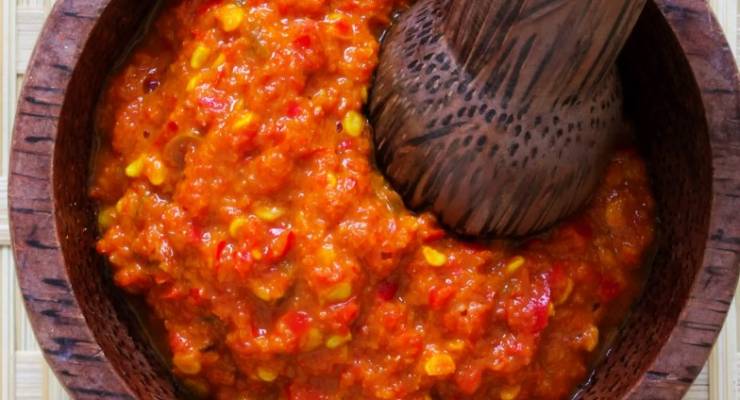
“Blachung” — there are as many alternate spellings as there are recipes — is for many top end families the sauce (or sambal) that keeps them together and provides a common culinary reference point.
As part of Darwin NAIDOC celebrations for 2019, the Larrakia Nation Aboriginal Corporation, hosts and organisers of many of this week’s great events, held a competition to find the best blachung sauce at its Coconut Grove headquarters.
I caught up with a few locals to see what they thought about their favourite condiment. Like a mug I asked Larrakia man Mark Motlop who made the best blachung. “Mine!” he responded. And the second best? “Mine!”
Mark went on to explain that plenty of his aunties made blachung: “Everyone has their own different style of making it and everyone thinks that theirs is the best … The Indonesians have their own different style — they call it “belachan” — and there’s “blachan”, which you can buy in blocks from the shops, and then there’s the “blachung” that I’m used to. My father is from the Torres Strait, my mother is a Larrakia woman and I learnt to cook blachung from my father.”
Plenty of folks reckon that cooking blachung was not for the faint-hearted, not least because of the universal ingredient of shrimp — which can come in a dry block or as a paste — and the particular smells it puts off when cooked.
Mark reckon he tries to cook it indoors until his missus gets sick of the smell and sends him outside.
Northern Land Council CEO Marion Scrymgour reckons that you could always tell when her Mum had blachung on the go.
“… Not just that smell, but also the flies on the screen door – sometimes there would be hundreds of those big blue blowflies trying to get to that smell!” she says. “But when it was cooked, yum! It is just like honey to a lot of Aboriginal families in Darwin.”
Maisie Austin from the NT Stolen Generations Aboriginal Corporation reckons that her family would always cook inside the house: “I remember when dad used to make it everyone used to have to go outside because it just stank the place out.”
Apart from the extraordinary olfactory impacts and entomological attractions of cooking blachung, there was widespread agreement on its origins somewhere in Asia. Nigel Browne of the Larrakia Development Corporation noted the links between Darwin’s Asian history and demography and its favourite condiment.
“[Blachung] obviously has Asian influences but if you look at the history of Darwin over the last couple of centuries, for a long time the largest part of the population was Chinese and a lot of our Larrakia families have Chinese backgrounds as well,” he said. “But also Malay, Filipino, Indonesian, Timorese — all sorts. I think it has been more than a century of a cultural and culinary melting pot and blachung is one of the things that’s come along for the ride.
Wadjigan/Larrakia man Jerome Cubillo credits the early Macassan traders with the introduction of blachung and of the impact on good food on community relations.
“For me it has got to come from the Macassan trading days – bringing all their spices across to the top end for hundreds of years …” he says. “It might be just a unique thing to Darwin, growing up here with all the different cultural influences — the Chinese, the Filipino and more — that just added to the mix. Our mob like the flavours and it caught on, and was adapted locally of course. I think it speaks about how diverse Darwin is and how we are really fortunate here.”
This excerpt is from Bob Gosford’s Northern Myth blog. Read the full post here.








Blachung. The ingredient that makes bully beef taste excellent.